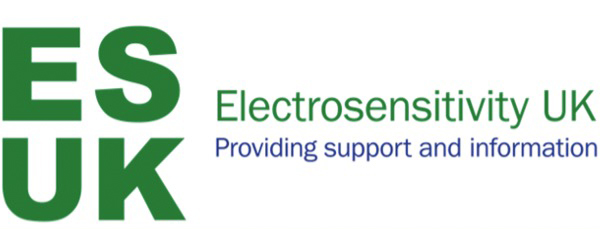Electrosensitivity UK’s aim is to support people already electrosensitive and to inform the public of the health risks of RFR and EMFs. Find out more here:
Electrosensitivity UK (ES-UK) was founded at meetings in London, at The Royal Society of Medicine, and in Bristol, home to the university where a founding trustee was a professor, in 2003, with charity registration (no. 1103018) in 2004. The number of people in contact with the charity has grown steadily, as more people have become sensitised to radiofrequency radiation (RFR) and electromagnetic fields (EMFs) from electronic devices such as Wi-Fi, Bluetooth, mobile phones, mobile phone masts, wireless smart meters and cordless phones, along with power lines, substations and electric motors.
The charity has two aims: to support people already electrosensitive, and to inform the public of the health risks of RFR and EMFs. It provides a website with resources, a newsletter, telephone and mail contact, leaflets and conferences, in addition to answering media queries. Its trustees are mostly electrosensitive themselves and have wide experience of the varied symptoms and many challenges of the condition.
Recognised source of reliable information on Electrosensitivity
In its early years the charity was one of the few recognised sources of reliable information on Electrosensitivity (ES) and Electromagnetic Hypersensitivity (EHS). Nowadays, especially following the Scientific International Consensus Report of 2021 on EHS by 32 worldwide experts, the physical aspects of the condition and its markers are better known. More medical physicians are able to diagnose EHS through careful clinical examinations of signs and symptoms in relation to the time and place of their occurrence. Sometimes medical physicians can additionally source aids such as evidence from cerebral blood perfusion and fMRI scans or biomarker and genetic tests.
The charity promotes a wider awareness on the scientific evidence for physiological ES and EHS at non-thermal levels, described in the scientific literature since 1733 and 1746 respectively for electric fields. Non-thermal adverse effects from electromagnetic fields, as in RFR, have been known since 1896, and in 1932 the condition of EHS was identified among radio and electrical workers. Short-term conscious provocation tests for ES and EHS have shown 100% accuracy when performed on screened subjects and with each subject’s results assessed individually and not averaged, while other studies have correlated ES and EHS signs and symptoms with RFR from mobile phone masts.
Scientific International Consensus Report
The charity follows the Scientific International Consensus Report (1) in affirming that EHS is a physiological intolerance or syndrome and distinct from Electrophobia or Radiophobia, a nocebo response, known as a separate psychological condition since 1903. Many of the charity’s contacts are unaware adults and children who become EHS without prior psychological conditioning, rendering the hypothesis of a nocebo response impossible.
The charity also highlights the long-term and often subconscious results of ES and EHS in the form of infertility, cardiovascular and neurological harm, and cancers. Cancer from RFR was discovered in 1953 (2) and from EMFs (3,4) in 1979. The IARC classifies RFR and EMFs at non-thermal levels as 2B possible carcinogens, with RFR confirmed as a definite cancer agent by the $30m NPT study in 2018, and by other studies. (5,6)
Resources for people with EHS
In recent years the charity has provided resources for people with EHS facing a threat to their employment. To retain their jobs, they need employers to adopt suitable accommodations. Some courts worldwide have sought to protect basic human rights for people with EHS under Health & Safety At Work and Equality legislation. The same has been true for children with EHS where courts have required Wi-Fi and mobiles to be removed from schools. Some courts have classified people with EHS as interested parties in decisions over the siting of phone masts, while others have required the removal of smart meters and LED lights for people harmed by them.
The charity also aims to increase awareness among planners and regulators about those public and private areas difficult or impossible for people with EHS to access equally with other people. These include hospitals, schools, shops, trains, buses and houses with Wi-Fi, smart meters, nearby phone masts or mobile phones in use. Some people who are badly affected are forced to live in cars or tents in forests or wild areas, if they can find anywhere free of manmade RFR.
The charity also aims to provide general advice on the protection currently necessary for people with EHS. Shielding nets and shielded buildings can help in some areas but they are not usually a sufficient solution for wider equality of access to public spaces. They are also very expensive for people who have often been forced out of a paid job.
One rewarding aspect of the charity’s work is providing scientific information for relatives and friends of people with EHS to counter misinformation which can lead to a denial of the physiological condition. This denial can force the person with EHS into further social exclusion, additional to the physical effects. It has even driven some to suicide.
Equally rewarding for the charity is when people adopt hygienic practices to protect against electrosmog. This includes switching off Wi-Fi when not in use and at night, or reducing use of mobile phones, or moving home further from phone masts or power lines. The charity looks forward to the time when much greater awareness of the needs of people with ES and EHS will mean that these aspects of its work are no longer needed.
How do radio frequency radiation and electromagnetic fields affect human beings?
References:
(1) https://pubmed.ncbi.nlm.nih.gov/34298941/
(2) McLaughlin JT: “A Study of Possible Health Hazards from Exposure to Microwave Radiation” Hughes Aircraft Copr., Culver City, Calif. (1953) in: Lundquist M: “A half-century ago physicists missed a major public service opportunity, costing the human race widespread chronic illness and many deaths!” BAPS. American Physical Society Meeting, March 21–25, 2005, Los Angeles, CA, L19.00007. (2005) Bulletin. Abstract.
(3) https://pubmed.ncbi.nlm.nih.gov/453167/
(4) https://pubmed.ncbi.nlm.nih.gov/19052983/


